第六版微观经济学课后习题答案
微观经济学曼昆第六版课后答案
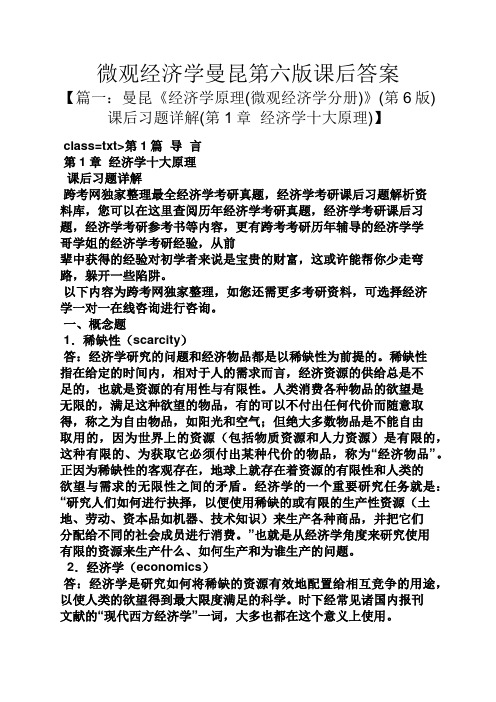
微观经济学曼昆第六版课后答案【篇一:曼昆《经济学原理(微观经济学分册)》(第6版)课后习题详解(第1章经济学十大原理)】class=txt>第1篇导言第1章经济学十大原理课后习题详解跨考网独家整理最全经济学考研真题,经济学考研课后习题解析资料库,您可以在这里查阅历年经济学考研真题,经济学考研课后习题,经济学考研参考书等内容,更有跨考考研历年辅导的经济学学哥学姐的经济学考研经验,从前辈中获得的经验对初学者来说是宝贵的财富,这或许能帮你少走弯路,躲开一些陷阱。
以下内容为跨考网独家整理,如您还需更多考研资料,可选择经济学一对一在线咨询进行咨询。
一、概念题1.稀缺性(scarcity)答:经济学研究的问题和经济物品都是以稀缺性为前提的。
稀缺性指在给定的时间内,相对于人的需求而言,经济资源的供给总是不足的,也就是资源的有用性与有限性。
人类消费各种物品的欲望是无限的,满足这种欲望的物品,有的可以不付出任何代价而随意取得,称之为自由物品,如阳光和空气;但绝大多数物品是不能自由取用的,因为世界上的资源(包括物质资源和人力资源)是有限的,这种有限的、为获取它必须付出某种代价的物品,称为“经济物品”。
正因为稀缺性的客观存在,地球上就存在着资源的有限性和人类的欲望与需求的无限性之间的矛盾。
经济学的一个重要研究任务就是:“研究人们如何进行抉择,以便使用稀缺的或有限的生产性资源(土地、劳动、资本品如机器、技术知识)来生产各种商品,并把它们分配给不同的社会成员进行消费。
”也就是从经济学角度来研究使用有限的资源来生产什么、如何生产和为谁生产的问题。
2.经济学(economics)答:经济学是研究如何将稀缺的资源有效地配置给相互竞争的用途,以使人类的欲望得到最大限度满足的科学。
时下经常见诸国内报刊文献的“现代西方经济学”一词,大多也都在这个意义上使用。
自从凯恩斯的名著《就业、利息和货币通论》于1936年发表之后,西方经济学界对经济学的研究便分为两个部分:微观经济学与宏观经济学。
曼昆《经济学原理》第6版 微观经济学分册 第7章 课后习题答案p157p159

第三篇市场和福利第七章消费者、生产者与市场效率问题与应用1.Melissa用120美元购买了一个iPod,并得到了80美元的消费者剩余。
A.她的支付意愿是多少?答:消费者剩余等于支付意愿减去付出的价格。
因此,梅莉莎须支付200 美元($120 + $80)。
B.如果她在降价销售时买了售价为90美元的iPod,她的消费者剩余会是多少?答:此时,她的消费者剩余为:200-90 =110 美元。
C.如果iPod的价格是250美元,她的消费者剩余会是多少?答:如果iPod 的价格是250 美元,其价格大于梅莉莎的支付愿意,因此她不会再买,这时的消费者剩余就为零。
2.加利福尼亚早来的寒流使柠檬变酸。
柠檬市场上消费者剩余会有什么变动?柠檬水市场上消费者剩余会有什么变动?用图形说明你的答案。
答:柠檬变酸,消费者对柠檬的评价下降,需求曲线向左下方移动。
在其他条件不变的情况下,消费者剩余减少。
如图7-2(a)所示,柠檬质量下降,使需求曲线从D1下降到D 2,△APE是原先的消费者剩余,△A′P′E′是变动后的消费者剩余,△APE>△A′P′E′。
由于柠檬价格的下降,柠檬水的投入成本减少,柠檬水的价格也下降。
在其他条件不变的情况下,柠檬水市场上消费者剩余增加,如图7-2(b)所示。
图7-2 寒流的影响3.假设对法国面包的需求增加。
在法国面包市场上,生产者剩余会发生什么变动?在面粉市场上,生产者剩余会发生什么变动?用图形说明你的答案。
答:由于需求增加,在其他条件不变的情况下,法国面包的价格会上升,市场上的生产者剩余增加。
如图7 -3(a),价格从P1 上升到P2 ,销量从Q 1上升到Q 2,生产者剩余从面积P1BE1增加到面积P2BE2 。
由于面包产量上升,它的生产要素面粉的需求量也会上升。
在其他条件不变的情况下,面粉价格上升,市场上的生产者剩余增加。
如图7-3(b)所示,生产者剩余从面积P1BE1增加到面积P2BE2 。
第六版微观经济学课后习题答案
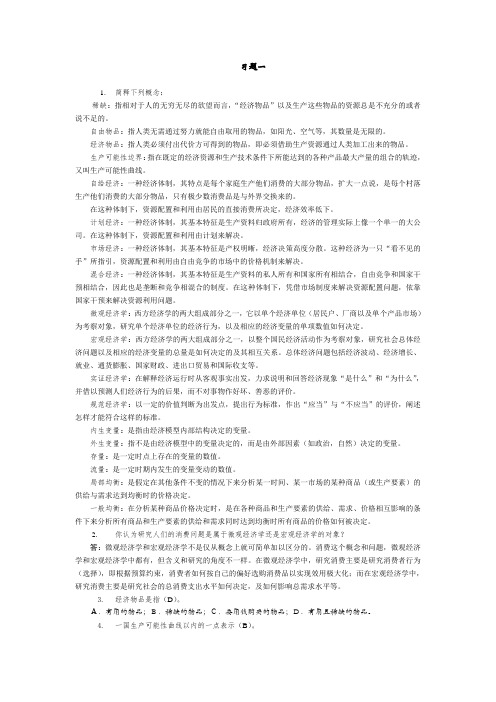
习题一1.简释下列概念:稀缺:指相对于人的无穷无尽的欲望而言,“经济物品”以及生产这些物品的资源总是不充分的或者说不足的。
自由物品:指人类无需通过努力就能自由取用的物品,如阳光、空气等,其数量是无限的。
经济物品:指人类必须付出代价方可得到的物品,即必须借助生产资源通过人类加工出来的物品。
生产可能性边界:指在既定的经济资源和生产技术条件下所能达到的各种产品最大产量的组合的轨迹,又叫生产可能性曲线。
自给经济:一种经济体制,其特点是每个家庭生产他们消费的大部分物品,扩大一点说,是每个村落生产他们消费的大部分物品,只有极少数消费品是与外界交换来的。
在这种体制下,资源配置和利用由居民的直接消费所决定,经济效率低下。
计划经济:一种经济体制,其基本特征是生产资料归政府所有,经济的管理实际上像一个单一的大公司。
在这种体制下,资源配置和利用由计划来解决。
市场经济:一种经济体制,其基本特征是产权明晰,经济决策高度分散。
这种经济为一只“看不见的手”所指引,资源配置和利用由自由竞争的市场中的价格机制来解决。
混合经济:一种经济体制,其基本特征是生产资料的私人所有和国家所有相结合,自由竞争和国家干预相结合,因此也是垄断和竞争相混合的制度。
在这种体制下,凭借市场制度来解决资源配置问题,依靠国家干预来解决资源利用问题。
微观经济学:西方经济学的两大组成部分之一,它以单个经济单位(居民户、厂商以及单个产品市场)为考察对象,研究单个经济单位的经济行为,以及相应的经济变量的单项数值如何决定。
宏观经济学:西方经济学的两大组成部分之一,以整个国民经济活动作为考察对象,研究社会总体经济问题以及相应的经济变量的总量是如何决定的及其相互关系。
总体经济问题包括经济波动、经济增长、就业、通货膨胀、国家财政、进出口贸易和国际收支等。
实证经济学:在解释经济运行时从客观事实出发,力求说明和回答经济现象“是什么”和“为什么”,并借以预测人们经济行为的后果,而不对事物作好坏、善恶的评价。
曼昆《经济学原理(微观经济学分册)》第6版课后习题详解(1~2章)
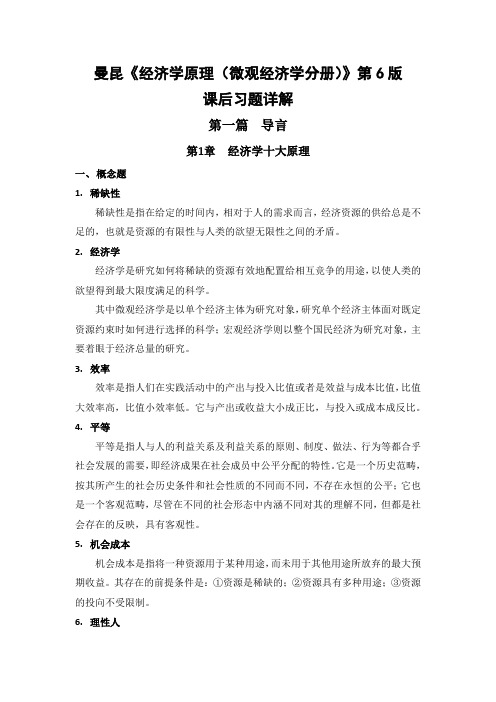
曼昆《经济学原理(微观经济学分册)》第6版课后习题详解第一篇导言第1章经济学十大原理一、概念题1.稀缺性稀缺性是指在给定的时间内,相对于人的需求而言,经济资源的供给总是不足的,也就是资源的有限性与人类的欲望无限性之间的矛盾。
2.经济学经济学是研究如何将稀缺的资源有效地配置给相互竞争的用途,以使人类的欲望得到最大限度满足的科学。
其中微观经济学是以单个经济主体为研究对象,研究单个经济主体面对既定资源约束时如何进行选择的科学;宏观经济学则以整个国民经济为研究对象,主要着眼于经济总量的研究。
3.效率效率是指人们在实践活动中的产出与投入比值或者是效益与成本比值,比值大效率高,比值小效率低。
它与产出或收益大小成正比,与投入或成本成反比。
4.平等平等是指人与人的利益关系及利益关系的原则、制度、做法、行为等都合乎社会发展的需要,即经济成果在社会成员中公平分配的特性。
它是一个历史范畴,按其所产生的社会历史条件和社会性质的不同而不同,不存在永恒的公平;它也是一个客观范畴,尽管在不同的社会形态中内涵不同对其的理解不同,但都是社会存在的反映,具有客观性。
5.机会成本机会成本是指将一种资源用于某种用途,而未用于其他用途所放弃的最大预期收益。
其存在的前提条件是:①资源是稀缺的;②资源具有多种用途;③资源的投向不受限制。
6.理性人理性人是指系统而有目的地尽最大努力去实现其目标的人,是经济研究中所假设的、在一定条件下具有典型理性行为的经济活动主体。
7.边际变动边际变动是指对行动计划的微小增量调整。
8.激励激励是指引起一个人做出某种行为的某种东西。
9.市场经济市场经济是指由家庭和企业在市场上的相互交易决定资源配置的经济,而资源配置实际上就是决定社会生产什么、生产多少、如何生产以及为谁生产的过程。
10.产权产权是指个人拥有并控制稀缺资源的能力,也可以理解为人们对其所交易东西的所有权,即人们在交易活动中使自己或他人在经济利益上受益或受损的权力。
曼昆微观经济学第六版答案
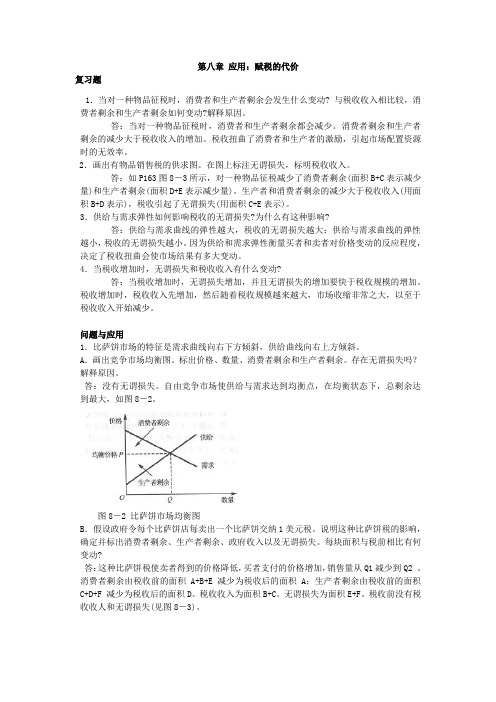
第八章应用:赋税的代价复习题1.当对一种物品征税时,消费者和生产者剩余会发生什么变动? 与税收收入相比较,消费者剩余和生产者剩余如何变动?解释原因。
答:当对一种物品征税时,消费者和生产者剩余都会减少。
消费者剩余和生产者剩余的减少大于税收收入的增加。
税收扭曲了消费者和生产者的激励,引起市场配置资源时的无效率。
2.画出有物品销售税的供求图。
在图上标注无谓损失,标明税收收入。
答:如P163图8-3所示,对一种物品征税减少了消费者剩余(面积B+C表示减少量)和生产者剩余(面积D+E表示减少量)。
生产者和消费者剩余的减少大于税收收入(用面积B+D表示),税收引起了无谓损失(用面积C+E表示)。
3.供给与需求弹性如何影响税收的无谓损失?为什么有这种影响?答:供给与需求曲线的弹性越大,税收的无谓损失越大;供给与需求曲线的弹性越小,税收的无谓损失越小。
因为供给和需求弹性衡量买者和卖者对价格变动的反应程度,决定了税收扭曲会使市场结果有多大变动。
4.当税收增加时,无谓损失和税收收入有什么变动?答:当税收增加时,无谓损失增加,并且无谓损失的增加要快于税收规模的增加。
税收增加时,税收收入先增加,然后随着税收规模越来越大,市场收缩非常之大,以至于税收收入开始减少。
问题与应用1.比萨饼市场的特征是需求曲线向右下方倾斜,供给曲线向右上方倾斜。
A.画出竞争市场均衡图。
标出价格、数量、消费者剩余和生产者剩余。
存在无谓损失吗?解释原因。
答:没有无谓损失。
自由竞争市场使供给与需求达到均衡点,在均衡状态下,总剩余达到最大,如图8-2。
图8-2 比萨饼市场均衡图B.假设政府令每个比萨饼店每卖出一个比萨饼交纳1美元税。
说明这种比萨饼税的影响,确定并标出消费者剩余、生产者剩余、政府收入以及无谓损失。
每块面积与税前相比有何变动?答:这种比萨饼税使卖者得到的价格降低,买者支付的价格增加,销售量从Q1减少到Q2 。
消费者剩余由税收前的面积A+B+E 减少为税收后的面积A;生产者剩余由税收前的面积C+D+F 减少为税收后的面积D。
曼昆《经济学原理》第6版微观经济学分册课后习题答案第10章
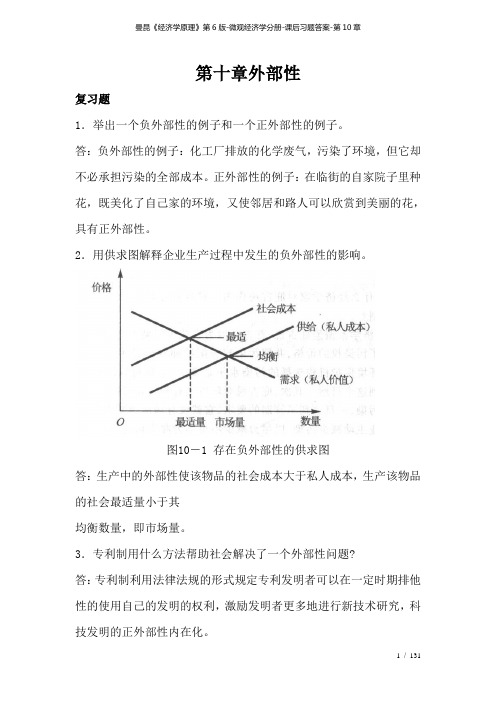
第十章外部性复习题1.举出一个负外部性的例子和一个正外部性的例子。
答:负外部性的例子:化工厂排放的化学废气,污染了环境,但它却不必承担污染的全部成本。
正外部性的例子:在临街的自家院子里种花,既美化了自己家的环境,又使邻居和路人可以欣赏到美丽的花,具有正外部性。
2.用供求图解释企业生产过程中发生的负外部性的影响。
图10-1 存在负外部性的供求图答:生产中的外部性使该物品的社会成本大于私人成本,生产该物品的社会最适量小于其均衡数量,即市场量。
3.专利制用什么方法帮助社会解决了一个外部性问题?答:专利制利用法律法规的形式规定专利发明者可以在一定时期排他性的使用自己的发明的权利,激励发明者更多地进行新技术研究,科技发明的正外部性内在化。
4.什么是矫正税?为什么就保护环境免受污染的方法而言,经济学家对矫正税的偏好大于管制?用于纠正负外部性影响的税收被称为矫正税。
这种税也被称为庇古税。
作为解决污染的方法,经济学家对矫正税的偏爱通常大于管制,因为税收可以以较低的社会成本减少污染。
首先是因为税收减少污染更有效率。
矫正税实际上规定了污染权的价格,并把污染权分配给那些减少污染成本最高的工厂。
无论环境保护机构选择的污染水平是多少,它都可以通过税收以最低的总成本达到这个目标。
其次,矫正税对环境更有利。
在管制政策下,企业被动地减少污染,一旦达到了管制的要求,它就没有理由再减少排污。
税收激励工厂主动减少污染,以尽力减少不得不为此支付的税收量。
5.列出不用政府干预时也可以解决外部性引起的问题的一些方法。
答:私人解决外部性所引起的问题的方法有:(1)用道德规范和社会约束来解决;(2)慈善行为;(3)通过依靠有关各方的私利来解决外部性问题;(4)利益各方签订合约。
6.设想你与一个吸烟者同住一间房,但你不吸烟。
根据科斯定理,什么因素决定了你的室友是否在房间里吸烟?这个结果有效率吗?你和你室友如何达成这种解决方法?答:根据科斯定理,如果我被迫吸烟所承受的成本大于我的室友吸烟所获得的收益,我的室友就不应该在房间里吸烟。
===平狄克《微观经济学》第六版习题答案_修改版1

===平狄克《微观经济学》第六版习题答案_修改版1第一章Array复习题1.多行业。
2对我们理解现实情况没有任何帮助。
3限制将改变市场的均衡。
A批评其破坏了市场的竞争性——是实证分析。
B被损坏——是实证分析。
4.由于两个市场在空间上是分离的,为零,则可以在Oklahoma购买汽油,到New Jersey补运输成本则不存在套利机会。
5教育费用提高了。
6圆贬值,持有美圆的消费者将面对较以前提高的价格。
第二章复习题1.假设供给曲线固定,练习题 1.a.E Q Q P PP Q Q P DD D D D ==.P = 80, E d =–0.4 P = 100, E d =–0.56b.E Q Q P PP Q Q P SS S S S ==.P = 80, E s =0.5 P = 100, E s =0.56c.均衡价格和数量为$100 ,18 million.d.价格定在80$,需求为20 million.,供给为16 million.,相差4 million. 2.Q S = 1,800 + 240P Q D = 2,580 - 194P .'Q D = (2,580 - 194P ) + 200 = 2,780 - 194P1,800 + 240P = 2,780 - 194P , or 434P = 980, or P* = $2.26 per bushel.Q S = 1,800 + (240)(2.26) = 2,342 Q D = 2,780 - (194)(2.26) = 2,342.3. a.100 - 5P = 50 + 5P , P = $500.Q D = 100 - (5)(5) = 75 Q S = 50 + (5)(5) = 75.租金在500美金时,750,000公寓可以被租掉。
当租金被控制在100美金时,供给量将达到550,000 (Q S = 50 + (5)(100) = 550),比管制前减少了200,000。
曼昆《经济学原理(微观经济学分册)》第6版课后习题详解(1~2章)
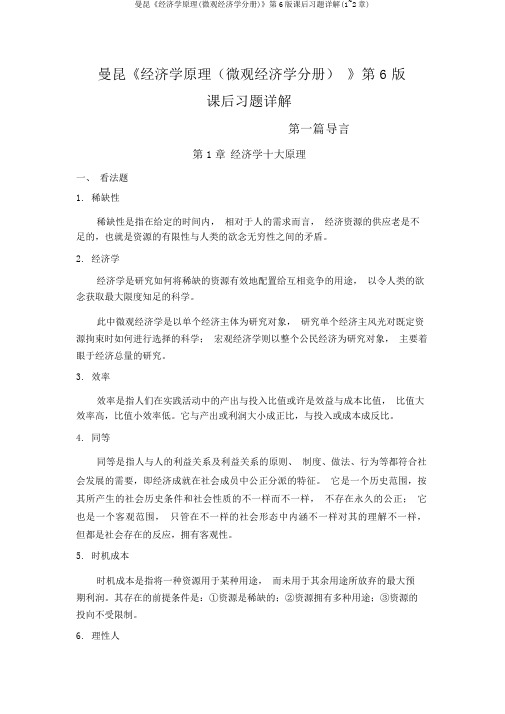
曼昆《经济学原理(微观经济学分册)》第 6 版课后习题详解第一篇导言第1章经济学十大原理一、看法题1.稀缺性稀缺性是指在给定的时间内,相对于人的需求而言,经济资源的供应老是不足的,也就是资源的有限性与人类的欲念无穷性之间的矛盾。
2.经济学经济学是研究如何将稀缺的资源有效地配置给互相竞争的用途,以令人类的欲念获取最大限度知足的科学。
此中微观经济学是以单个经济主体为研究对象,研究单个经济主风光对既定资源拘束时如何进行选择的科学;宏观经济学则以整个公民经济为研究对象,主要着眼于经济总量的研究。
3.效率效率是指人们在实践活动中的产出与投入比值或许是效益与成本比值,比值大效率高,比值小效率低。
它与产出或利润大小成正比,与投入或成本成反比。
4.同等同等是指人与人的利益关系及利益关系的原则、制度、做法、行为等都符合社会发展的需要,即经济成就在社会成员中公正分派的特征。
它是一个历史范围,按其所产生的社会历史条件和社会性质的不一样而不一样,不存在永久的公正;它也是一个客观范围,只管在不一样的社会形态中内涵不一样对其的理解不一样,但都是社会存在的反应,拥有客观性。
5.时机成本时机成本是指将一种资源用于某种用途,而未用于其余用途所放弃的最大预期利润。
其存在的前提条件是:①资源是稀缺的;②资源拥有多种用途;③资源的投向不受限制。
6.理性人理性人是指系统而有目的地尽最大努力去实现其目标的人,是经济研究中所假定的、在必定条件下拥有典型理性行为的经济活动主体。
7.边沿改动边沿改动是指对行动计划的细小增量调整。
8.激励激励是指惹起一个人做出某种行为的某种东西。
9.市场经济市场经济是指由家庭和公司在市场上的互相交易决定资源配置的经济,而资源配置本质上就是决定社会生产什么、生产多少、如何生产以及为谁生产的过程。
10.产权产权是指个人拥有并控制稀缺资源的能力,也能够理解为人们对其所交易东西的所有权,即人们在交易活动中使自己或别人在经济利益上得益或受损的权利。
曼昆《经济学原理》第6版微观经济学分册第6章课后习题答案

曼昆《经济学原理》第6版微观经济学分册第6章课后习题答案曼昆《经济学原理》第6版微观经济学分册第6章课后习题答案曼昆《经济学原理》第6版微观经济学分册第5章课后习题答案P132-P134 第六章供给、需求与政府政策复习题1(举出一个价格上限的例子和一个价格下限的例子。
答:为了保障城镇中低收入居民的住房需求,国家对城镇居民中的安居工程售房制定最高限价。
为了保护农民种粮的积极性,对粮食的国家合同定购部分收购时制定最低限价,以保护农民的利益;。
2(什么引起了一种物品的短缺,是价格上限还是价格下限?用图形证明你的答案。
答:当价格上限低于市场均衡价格时会引起一种物品的短缺。
当价格下限高于市场均衡价格时会引起一种物品的过剩。
3(当不允许一种物品的价格使供给与需求平衡时,配置资源的机制是什么?答:当政府对竞争市场实行限制性价格上限时,就产生了物品的短缺。
卖者必然在大量买者中配置稀缺物品。
这时的配给机制可能是排长队,或者是卖者根据自己的偏好来配给物品。
当政府对竞争市场实行限制性价格下限时,就产生了过剩。
过剩会引起一些不合意的配给机制,例如那些也许由于种族或家族之故而受买者青睐的卖者能比那些没有受到青睐的卖者更好地出售自己的物品。
4(解释为什么经济学家通常总是反对价格控制?答:因为在市场经济中,价格对资源配置起着调节作用。
如果人为的控制价格,往往会造成某种物品的过剩或短缺,从而使生产者和消费者的利益受到伤害,破坏市场配置资源的有效性。
5(假设政府取消向一种物品的买者征税,而向这种物品的卖者征同样的税。
税收政策的这种变动如何影响买者为这种物品向卖者支付的价格、买者所支付的包括税在内的货币量、卖者扣除税收得到的货币量以及销售量,答:税收政策的变动对它们都不产生影响。
因为税收的归宿取决于供给和需求的价格弹性,而不取决于向买者征税还是向卖者征税。
6(一种物品的税收如何影响买者支付的价格、卖者得到的价格,以及销售量?答:一种物品的税收使买者支付的价格上升,卖者得到的价格下降,销售量下降。
平狄克微观经济学第六版第三章课后答案

PART IIPRODUCERS, CONSUMERS, AND COMPETITIVE MARKETSCHAPTER 3CONSUMER BEHAVIORChapter 3 builds the foundation for deriving the demand curve in Chapter 4. In order tounderstand demand theory, students must have a firm grasp of indifference curves, the marginal rateof substitution, the budget line, and optimal consumer choice. It is possible to discuss consumer choicewithout going into extensive detail on utility theory. Many students find utility functions to be a moreabstract concept than preference relationships. However, if you plan to discuss uncertainty in Chapter5, you will need to cover marginal utility (section 3.5). Even if you cover utility theory only briefly,make sure students are comfortable with the term utility because it appears frequently in Chapter 4.When introducing indifference curves, stress that physical quantities are represented on thetwo axes. After discussing supply and demand, students may think that price should be on the verticalaxis. To illustrate the indifference curves, pick an initial bundle on the graph and ask which otherbundles are likely to be more preferred and less preferred to the initial bundle. This will divide thegraph into four quadrants, and it is then easier for students to figure out the set of bundles betweenwhich the consumer is indifferent. It is helpful to present a lot of examples with different types ofgoods and see if the class can figure out how to draw the indifference curves. The examples are alsouseful for explaining the significance of the assumptions made about preferences. In presentingdifferent examples, you can ask which assumption would be violated.Explaining utility follows naturally from the discussion of indifference curves. Though anabstract concept, it is possible to get students to understand the basic idea without spending too muchtime on the topic. You might point out that we as consumers have a goal in life, which is to maximizeour utility subject to our budget constraint. When we go to the store we pick the basket that we likebest and that stays within our budget. From this we derive demand curves. Emphasize that it is theranking that is important and not the utility number, and point out that if we can graph an indifferencecurve we can certainly find an equation to represent it. Finally, what is most important is the rate atwhich consumers are willing to exchange goods (the marginal rate of substitution) and this is based onthe relative satisfaction that they derive from each good at any particular time.The marginal rate of substitution, MRS, can be confusing to students. Some confuse the MRSwith the ratio of the two quantities. If this is the case, point out that the slope is equal to the ratio of the rise, ∆Y, and the run, ∆X. This ratio is equal to the ratio of the intercepts of a line just tangent to the indifference curve. As we move along a convex indifference curve, these intercepts and the MRSchange. Another problem is the terminology “of X for Y.” This is confus ing because we are notsubstituting “X for Y,” but Y for one unit of X. You may want to present a variety of examples in classto explain this important concept.1. What are the four basic assumptions about individual preferences? Explain thesignificance or meaning of each.(1) Preferences are complete: this means that the consumer is able to compare andrank all possible baskets; (2) Preferences are transitive: this means that preferencesare consistent, in that if bundle A is preferred to bundle B and bundle B is preferredto bundle C, then we should be able to conclude that bundle A is preferred to bundleC; (3) More is preferred to less: this means that all goods are desirable, and that theconsumer will always prefer to have more of a good; (4) Diminishing marginal rateof substitution: this means that indifference curves are convex, and that the slope ofthe indifference curve increases (becomes less negative) as we move down along thecurve. As a consumer moves down along her indifference curve she is willing to giveup fewer units of the good on the vertical axis in exchange for one more unit of thegood on the horizontal axis. This assumption also means that balanced marketbaskets are preferred to baskets that have a lot of one good and very little of theother good.2. Can a set of indifference curves be upward sloping? If so, what would this tell you about the two goods?A set of indifference curves can be upward sloping if we violate assumption numberthree; more is preferred to less. When a set of indifference curves is upward sloping,it means one of the goods is a “bad” in that the consumer prefers less of the goodrather than more of the good. The positive slope means that the consumer willaccept more of the bad good only if she also receives more of the other good in return.As we move up along the indifference curve the consumer has more of the good sheb.Draw a set of indifference curves for Jon.Since Jon is always willing to trade one can of coke for one can of sprite, hisindifference curves are linear with a slope of –1.c.Draw two budget lines with different slopes and illustrate the satisfaction-maximizing choice. What conclusion can you draw?Jon’s indifference curves are linear with a slope of –1. Jon’s budget line is alsolinear, and will have a slope that reflects the ratio of the two prices. If Jon’s budgetline is steeper than his indifference curves then he will choose to consume only thegood on the vertical axis. If Jon’s b udget line is flatter than his indifference curvesthen he will choose to consumer only the good on the horizontal axis. Jon willalways choose a corner solution, unless his budget line has the same slope as hisindifference curves. In this case any combination of Sprite and Coke that uses uphis entire income with maximize his satisfaction.5. What happens to the marginal rate of substitution as you move along a convex indifference curve? A linear indifference curve?The MRS measures how much of a good you are willing to give up in exchange for onemore unit of the other good, keeping utility constant. The MRS diminishes along aconvex indifference curve in that as you move down along the indifference curve, youare willing to give up less and less of the one good in exchange for the other. TheMRS is also the slope of the indifference curve, which increases (becomes lessnegative) as you move down along the indifference curve. The MRS is constantalong a linear indifference curve, since in this case the slope does not change. Theconsumer is always willing to trade the same number of units of one good inexchange for the other.6. Explain why an MRS between two goods must equal the ratio of the price of the goods for the consumer to achieve maximum satisfaction.The MRS describes the rate at which the consumer is willing to trade one good foranother to maintain the same level of satisfaction. The ratio of prices describes thetrade-off that the market is willing to make between the same two goods. Thetangency of the indifference curve with the budget line represents the point at whichthe trade-offs are equal and consumer satisfaction is maximized. If the MRS betweentwo goods is not equal to the ratio of prices, then the consumer could trade one good foranother at market prices to obtain higher levels of satisfaction. For example, if theslope of the budget line (the ratio of the prices) is –4 then the consumer can trade 4units of good 2 for one unit of good 1. If the MRS at the current bundle is –6, then theconsumer is willing to trade 6 units of good 2 for one unit of good 1. Since the twoslopes are not equal the consumer is not maximizing her satisfaction. The consumer iswilling to trade 6 but only has to trade 4, so she should make the trade. This tradingcontinues until the highest level of satisfaction is achieved. As trades are made, theMRS will change and become equal to the price ratio.7. Describe the indifference curves associated with two goods that are perfect substitutes. What if they are perfect complements?Two goods are perfect substitutes if the MRS of one for another is a constant number.Given the MRS is a constant number, the slope of the indifference curves will beconstant, and the indifference curves are therefore linear. If two goods are perfectcomplements, the indifference curves are L-shaped. In this case the consumerwants to consume the two goods in a fixed proportion, say one unit of good 1 for every1 unit of good 2. If she has more of one good but not more of the other then she doesnot get any extra satisfaction.8. What is the difference between ordinal utility and cardinal utility? Explain why the assumption of cardinal utility is not needed in order to rank consumer choices.Ordinal utility implies an ordering among alternatives without regard for intensity ofpreference. For example, if the consumer’s first choice is preferred to their secondchoice, then utility from the first choice will be higher than utility from the secondchoice. How much higher is not important. An ordinal utility function generates aranking of bundles and no meaning is given to the utility number itself. Cardinalutility implies that the intensity of preferences may be quantified, and that the utilitynumber itself has meaning. An ordinal ranking is all that is needed to rank consumerchoices. It is not necessary to know how intensely a consumer prefers basket A overbasket B; it is enough to know that A is preferred to B.9. Upon merging with the West German economy, East German consumers indicated a preference for Mercedes-Benz automobiles over Volkswagens. However, when they converted their savings into deutsche marks, they flocked to Volkswagen dealerships. How can you explain this apparent paradox?Three assumptions are required to address this question: 1) that a Mercedes costs morethan a Volkswagen; 2) that the East German consumers’ utility function comprises twogoods, automobiles and all other goods evaluated in deutsche marks; and 3) that EastGermans have incomes. Based on these assumptions, we can surmise that while EastGerman consumers may prefer a Mercedes to a Volkswagen, they either cannot afford aMercedes or they prefer a bundle of other goods plus a Volkswagen to a Mercedes alone.While the marginal utility of consuming a Mercedes exceeds the marginal utility ofconsuming a Volkswagen, the consumer will consider marginal utility per dollar foreach good. This means the marginal utility per dollar must have been higher for theVolkswagen since consumers flocked to the Volkswagen dealerships and not theMercedes dealerships.10. Draw a budget line and then draw an indifference curve to illustrate the satisfaction maximizing choice associated with two products. Use your graph to answer the following questions.a.Suppose that one of the products is rationed. Explain why the consumer is likelyto be worse off.When goods are not rationed, the consumer is able to choose the satisfaction-maximizing bundle where the slope of the budget line is equal to the slope of theindifference curve, or the price ratio is equal to the MRS. This is point A in the graphbelow. If good 1 is now rationed the consumer will not be able to attain the utilitymaximizing point. He or she will have to consume more of the other good instead.This is point B below.b.Suppose now that the price of one of the products is fixed at a level below thecurrent price. As a result, the consumer is not able to purchase as much as she would like of the product. Can you tell if the consumer is better off or worse off?When the price of the good is fixed at a level below the current (equilibrium) price,there will be a shortage of the good and the good will have to be effectively rationed.As in the question above, the consumer is worse off because she is not able to attainher utility maximizing point.11. Based on his preferences, Bill is willing to trade 4 movie tickets for 1 ticket to a basketball game. If movie tickets cost $8 each and a ticket to the basketball game costs $40, should Bill make the trade? Why or why not?No Bill should not make the trade. If he gives up the 4 movie tickets then he willsave $8 per ticket for a total of $32. However, this is not enough for a basketballticket. He would in fact have to give up 5 movie tickets if he wanted to buy anotherbasketball ticket. Notice also, that the marginal utility per dollar is higher for movietickets so Bill will be better off if he consumes more movie tickets and fewerbasketball tickets. To figure this out recall that what Bill is willing to do defines hisMRS. His MRS is 4 so this means that the marginal utility of a basketball game is 4and the marginal utility of a movie is 1:MRS=-4=-MUballMUmovie=-41.Now the marginal utility per dollar can be computed:MUball Pball =440=110MUmovie Pmovie =18.12. Describe the equal marginal principle. Explain why this principle may not hold if increasing marginal utility is associated with the consumption of one or both goods.The equal marginal principle states that the ratio of the marginal utility to price mustbe equal across all goods to obtain maximum satisfaction. In other words, utilitymaximization is achieved when the budget is allocated so that the marginal utility perdollar of expenditure is the same for each good. If the marginal utility per dollar is notequal then utility can be increased by allocating more dollars to the good with thehigher marginal utility per dollar. The consumer will obtain more “bang for the buck”if they reallocate their dollars.If marginal utility is increasing, the consumer maximizes satisfaction by consumingever larger amounts of the good. Thus, the consumer would spend all income on onegood, assuming a constant price, resulting in a corner solution. With a corner solution,the equal marginal principle cannot hold.13. The price of computers has fallen substantially over the past two decades. Use this drop in price to explain why the Consumer Price Index is likely to overstate substantially the cost-of-living index for individuals who use computers intensively.The consumer price index measures the cost of a typical basket of goods purchased bythe consumer in the current year relative to the cost of the basket in the base year.Each good in the basket is assigned a weight, which reflects the importance of the goodto the consumer, and the weights are kept fixed from year to year. The problem withfixing the weights is that consumers will shift their purchases from year to year to givemore weight to goods whose prices have fallen, and less weight to goods whose priceshave risen. The CPI will therefore give too much weight to goods whose prices haverisen, and too little weight to goods whose prices have fallen. For the individual whouses computers intensively, the fixed weight for computers in the basket willunderstate the importance of this good, and will hence understate the effect of the fallin the price of computers. The CPI will overstate the rise in the cost of living for thistype of individual.14. Explain why the Paasche index will generally understate the ideal cost-of-living index.The Paasche index measures the current cost of the current bundle of goods relativeto the base year cost of the current bundle of goods. The Paasche index willunderstate the ideal cost of living because it assumes the individual will buy thecurrent year bundle in the base period. In reality, at base year prices the consumerwould have been able to attain the same level of utility at a lower cost by alteringtheir consumption bundle. Since the base year cost is overstated, the denominatorwill be larger and the index will be lower, or understated.1. In this chapter, consumer preferences for various commodities did not change during the analysis. Yet in some situations, preferences do change as consumption occurs. Discuss why and how preferences might change over time with consumption of these two commodities:a. cigarettesThe assumption that preferences do not change is a reasonable one if choices areindependent across time. It does not hold, however, when “habit-forming” or addictivebehavior is involved, as in the case of cigarettes: the consumption of cigarettes in oneperiod influences their consumption in the next period.b. dinner for the first time at a restaurant with a special cuisineThis example is parallel to examples of adventure seeking. For some, a new diningexperience creates enthusiasm to seek out more exciting and different cuisines anddishes. For others, they develop a fondness for regularity and consistency or fear ofthe new and unknown. In either of these cases, choices change as consumption occurs.2. Draw indifference curves that represent the following individuals’ preferences for hamburgers and soft drinks. Indicate the direction in which the individuals’ satisfaction (or utility) is increasing.a.Joe has convex preferences and dislikes both hamburgers and soft drinks.Since Joe dislikes both goods, his set of indifference curves will be bowed inwardstowards the origin instead of outwards, as in the normal case where more is preferredto less. Given he dislikes both goods, his satisfaction is increasing in the direction ofthe origin. Convexity of preferences implies his indifference curves will have thenormal shape in that they are bowed towards the direction of increasing satisfaction.Convexity also implies that given any two bundles between which the consumer isindifferent, the “average” of the two bundles will be in the preferred set, or wi ll leavehim at least as well off.so ft dr in kb.Jane loves hamburgers and dislikes soft drinks. If she is served a soft drink, shewill pour it down the drain rather than drink it.Since Jane can freely dispose of the soft drink if it is given to her, she considers it to be aneutral good. This means she does not care about soft drinks one way or the other.With hamburgers on the vertical axis, her indifference curves are horizontal lines. Herso ft dr in kc.Bob loves hamburgers and dislikes soft drinks. If he is served a soft drink, he willdrink it to be polite.Since Bob will drink the soft drink in order to be polite, it can be thought of as a “bad”.When served another soft drink, he will require more hamburgers at the same timein order to keep his satisfaction constant. More soft drinks without morehamburgers will worsen his utility. More hamburgers and fewer soft drinks willincrease his utility.s o ft d rin kd.Molly loves hamburgers and soft drinks, but insists on consuming exactly one softdrink for every two hamburgers that she eats.Molly wants to consume the two goods in a fixed proportion so her indifference curvesare L-shaped. For any given amount of one good, she gets no extra satisfaction fromhaving more of the other good. She will only increase her satisfaction if she hasmore of both goods.s o ft d rin ke.Bill likes hamburgers, but neither likes nor dislikes soft drinks.Like Jane, Bill considers soft drinks to be a neutral good. Since he does not careabout soft drinks one way or the other we can assume that no matter how many hehas, his utility will be the same. His level of satisfaction depends entirely on hows o ft d rin kf.Mary always gets twice as much satisfaction from an extra hamburger as she doesfrom an extra soft drink.How much extra satisfaction Mary gains from an extra hamburger or soft drink tellsus something about the marginal utilities of the two goods, or about her MRS. If shealways receives twice the satisfaction from an extra hamburger then her marginalutility from consuming an extra hamburger is twice her marginal utility fromconsuming an extra soft drink. Her MRS, with hamburgers on the vertical axis, is1/2.so ft dr in k3. If Jane is currently willing to trade 4 movie tickets for 1 basketball ticket then she must like basketball better than movies. True or false? Explain.This statement is not necessarily true. If she is always willing to trade 4 movietickets for 1 basketball ticket then yes she likes basketball better because she willalways gain the same satisfaction from 4 movie tickets as she does from 1 basketballticket. However, it could be that she has convex preferences (diminishing marginalrate of substitution) and is at a bundle where she has a lot of movie tickets relative tobasketball tickets. This would make her willing to give up more movie tickets to getanother basketball ticket. It would not mean though that she liked basketball better.Her willingness to give up a good would in this case depend on the quantity of eachgood in her current basket.4. Janelle and Brian each plan to spend $20,000 on the styling and gas mileage features of a new car. They can each choose all styling, all gas mileage, or some combination of the two. Janelle does not care at all about styling and wants the best gas mileage possible. Brian likes both equally and wants to spend an equal amount on the two features. Using indifference curves and budget lines, illustrate the choice that each person will make.Assume styling is on the vertical axis and gas mileage is on the horizontal axis.Janelle has indifference curves that are vertical. If the styling is there she will takeit, but she otherwise does not care about it. As her indifference curves move over tothe right, she gains more gas mileage and more satisfaction. She will spend all$20,000 on gas mileage. Brian has indifference curves that are L-shaped. He willnot spend more on one feature than on the other feature. He will spend $10,000 onstyling and $10,000 on gas mileage.5. Suppose that Bridget and Erin spend their income on two goods, food (F) and clothing(C). Bridget’s preferences are represented by the utility function U(F,C)=10FC, while Erin’s preferences are represented by the utility function U(F,C)=.20F2C2.a.On a graph, with food on the horizontal axis and clothing on the vertical axis,identify the set of points that give Bridget the same level of utility as the bundle (10,5). Do the same for Erin on a separate graph.Bridget receives a utility of 10*10*5=500 from this bundle. The indifference curve isrepresented by the equation 10FC=500 or FC=50. Some bundles on this indifferencecurve are (5,10), (10,5), (25,2), and (2,25). Erin receives a utilityof .2*10*10*5*5=500 from the bundle (10,5). Her indifference curve is representedby the equation 500=.2F2C2, or 50=FC. This is the same indifference curve asBridget. Both indifference curves have the normal, convex shape.b.On the same two graphs, identify the set of bundles that give Bridget and Erin thesame level of utility as the bundle (15,8).For each person, plug in F=15 and C=8 into their respective utility functions. ForBridget, this gives her a utility of 1200, so her indifference curve is given by theequation 10FC=1200, or FC=120. Some bundles on this indifference curve are(12,10), (10,12), (3,40), and (40,3). For Erin, this bundle gives her a utility of 2880,so her indifference curve is given by the equation 2880=.2F2C2, or FC=120.This is the same indifference curve as Bridget.c.Do you think Bridget and Erin have the same preferences or different preferences?Explain.They have the same preferences because for any given bundle they have the samelevel of utility. This means that they will rank all bundles in the same order. Notehowever, that it is not necessary that they receive the same level of utility to have thesame set of preferences. All that is necessary is that they rank the bundles in thesame order.6. Suppose that Jones and Smith have each decided to allocate $1,000 per year to an entertainment budget in the form of hockey games or rock concerts. They both like hockey games and rock concerts and will choose to consume positive quantities of both goods. However, they differ substantially in their preferences for these two forms of entertainment. Jones prefers hockey games to rock concerts, while Smith prefers rock concerts to hockey games.a. Draw a set of indifference curves for Jones and a second set for Smith.Given they each like both goods and they will each choose to consume positivequantities of both goods, we can assume their indifference curves have the normalconvex shape. However since Jones has an overall preference for hockey and Smithhas an overall preference for rock concerts, their two sets of indifference curves willhave different slopes. Suppose that we place rock concerts on the vertical axis andhockey games on the horizontal axis, Jones will have a larger MRS than Smith.Jones is willing to give up more rock concerts in exchange for a hockey game since heprefers hockey games. The indifference curves for Jones will be steeper.b. Using the concept of marginal rate of substitution, explain why the two sets ofcurves are different from each other.At any combination of hockey games and rock concerts, Jones is willing to give up morerock concerts for an additional hockey game, whereas, Smith is willing to give up fewerrock concerts for an additional hockey game. Since the MRS is a measure of how manyof one good (rock concerts) an individual is willing to give up for an additional unit ofthe other good (hockey games), then the MRS, and hence the slope of the indifferencecurves, will be different for the two individuals.7. The price of DVDs (D) is $20 and the price of CDs (C) is $10. Philip has a budget of $100 to spend on the two goods. Suppose that he has already bought one DVD and one CD. In addition there are 3 more DVDs and 5 more CDs that he would really like to buy.a.Given the above prices and income, draw his budget line on a graph with CDs onthe horizontal axis.His budget line is PD D+PCC=I, or 20D+10C=100. If he spends his entire incomeon DVD’s he could afford to buy 5. If he spends his entire income on CD’s he couldafford to buy 10.b.Considering what he has already purchased, and what he still wants to purchase,identify the three different bundles of CDs and DVDs that he could choose.Assume that he cannot purchase fractional units for this part of the question.Given he has already purchased one of each, for a total of $30, he has $70 left. Sincehe wants 3 more DVD’s he can buy these for $60 and spend his remaining $10 on 1CD. This is the first bundle below. He could also choose to buy only 2 DVD’s for$40 and spend the remaining $30 on 3 CD’s. He can choose the following bundles: Purchased Quantities Total QuantitiesD C D C3 1 2 62 3 3 41 5 4 28. Anne has a job that requires her to travel three out of every four weeks. She has an annual travel budget and can either travel by train or by plane. The airline she typically flies with has a frequent traveler program that reduces the cost of her tickets depending on the number of miles she has flown in a given year. When she reaches 25,000 miles the airline will reduce the price of her tickets by 25% for the remainder of the year. When she reached 50,000 miles, the airline will reduce the price of her tickets by 50% for the remainder of the year. Graph Anne’s budget line, with train miles on the vertical axis and plane miles on the horizontal axis.The typical budget line is linear (with a constant slope) because the prices of the twogoods do not change as the consumer buys more or less of a particular good. In thiscase, the price of airline miles will change depending on how many miles shepurchases. As the price changes, the slope of the budget line will change. Sincethere are three prices, there will be three slopes, or two kinks, to the budget line.Since the price falls as she flies more miles, the budget line will become flatter withevery price change. See the graph in the problem below.9. Debra usually buys a soft drink when she goes to a movie theater, where she has a choice of three sizes: the 8 ounce drink costs $1.50, the 12 ounce drink, $2.00, and the 16 ounce drink, $2.25. Describe the budget constraint that Debra faces when deciding how many ounces of the drink to purchase. (Assume that Debra can costlessly dispose of any of the soft drink that she does not want.First notice that as the size of the drink increases, the price per ounce decreases.When she buys the 8-ounce soft drink she pays $1.508oz$0.19 per oz.When shebuys the 12-ounce size she pays $0.17 per ounce, and when she buys the 16-ounce size, she pays $0.14 per ounce. Given that there are three different prices per ounce of soft drink, the budget line will have two kinks in it, as illustrated below. Notice that at each kink, the slope of the budget line gets flatter (due to the decreasing cost per ounce relative to the “other good” on the vertical axis).O u n ces o fS o ft D rin k 81216。
高鸿业《西方经济学(微观部分)》(第6版)课后习题答案详解(完整版)
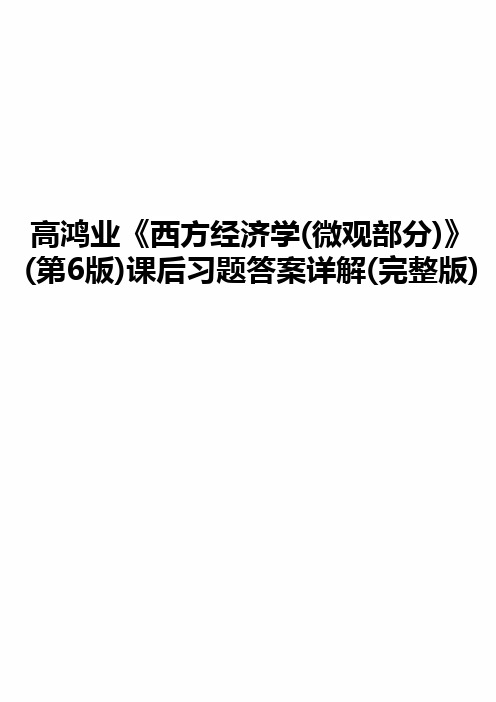
(1)在竞争性市场中,A的产出应是多少?
(2)社会最优的产出应是多少?
解:(1)在竞争性市场中,厂商A将根据利润最大化原则P=M C来安排生产,即A的产出应满足:
(1)如果农场主相信下雨的概率是50%,他会灌溉吗?
(2)假如天气预报的准确率是100%,农场主愿意为获得这种准确的天气信息支付多少费用?
解:(1)如果农场主相信下雨的概率是50%,不进行灌溉的话,他的预期利润为:
E(叶=0.5x1000+0.5x500=750(元)
如果进行灌溉,则肯定得到的利润为1000-200 = 800。因此,他会进行灌溉。
汀1+巧)=900—X
令E(x)=900—x=800(不购买预报信息时的利润),解出x=lOO。
高鸿业《西方经济学(微观部分)》(第6版)课后习题答案详解(完整版)
(100-q)+(200-q)=1:
解得:社会最优产出水平矿=90
这就是该公共物品的社会奻优产出水平。
(2)他不买天气预报信息时,如上所述,他会进行灌溉,得到利润800。如果买天气预报信息并假定支付x 元费用,他若确知天下雨,就不泄溉,于是可获利涧:
冗I=1()()()—X
若确知天不下雨,就灌溉,于是可获利润:
冗2=800-x
由于他得到的信息无非是下雨和不下雨,因此,在购买信息情况下的预期利涧为:
E(冗)=0.5(
(2)如该公共物品甘I私人生产,其产出水平为80。公共物品的最优数星通常没有考虑搭便车的问题。如果考虑搭便车,可以看出,一旦B提供了80单位的公共物品,则A可搭便车(不付钱即可享受)。需要注意的是,经济学中一般的结论是公共物品由私人提供的数量<公共物品的呆优提供数量<公共物品若为私人物品时的提供数嚣。如果这个结论严格成立,那么答案可能就是0,即B可能不提供公共物品。
曼昆《经济学原理(微观经济学分册)》(第6版)课后习题详解
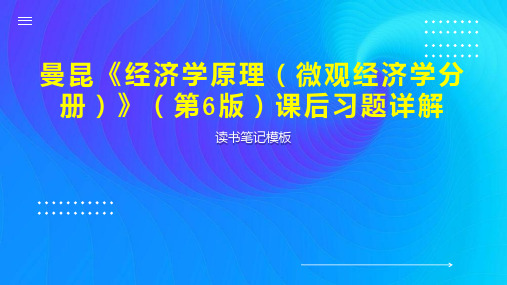
第14章竞争市场上 的企业
第13章生产成本
第15章垄断
第16章垄断 竞争
第17章寡头
第19章收入与歧视
第18章生产要素市 场
第20章收入不平等 与贫困
第21章消费 者选择理论
第22章微观 经济学前沿
作者介绍
读书笔记
这是《曼昆《经济学原理(微观经济学分册)》(第6版)课后习题详解》的读书笔记模板,可以替换为自己 的心得。
目录分析
第2章像经济学家 一样思考
第1章经济学十大 原理
第3章相互依存性 与贸易的好处
第5章弹性及其应 用
第4章供给与需求 的市场力量
第6章供给、需求 与政府政策
第8章应用:赋税 的代价
第7章消费者、生 产者与市场效率
第9章应用:国际 贸易
第11章公共物品和 公共资源
第10章外部性
第12章税制的设计
曼昆《经济学原理(微观经济学分 册)》(第6版)课后习题详解
读书笔记模板
01 思维导图
03 目录分析 05 读书笔记
目录
02 内容摘要 04 作者介绍 06 精彩摘录
思维导图
关键字分析思维导图
习题
教材
消费者
微观经济 学
企业
习题
供给
微观经 济学
经济学
原理
第章
需求
曼昆经济 学பைடு நூலகம்
市场
经济学家
第篇
收入
应用
税制
内容摘要
本书特别适用于参加研究生入学考试指定考研参考书目为曼昆《经济学原理(微观经济学分册)》的考生, 也可供各大院校学习曼昆《经济学原理(微观经济学分册)》的师生参考。曼昆的《经济学原理》是世界上最流 行的初级经济学教材,也被众多院校列为经济类专业考研重要参考书目。为了帮助学生更好地学习这本教材,我 们有针对性地编著了它的配套辅导用书(均提供免费下载,免费升级):1.曼昆《经济学原理(微观经济学分 册)》(第6版)笔记和课后习题详解(含考研真题)[视频讲解]2.曼昆《经济学原理(微观经济学分册)》 【教材精讲+考研真题解析】讲义与视频课程【35小时高清视频】3.曼昆《经济学原理(微观经济学分册)》 (第6版)课后习题详解4.曼昆《经济学原理(微观经济学分册)》(第5版)课后习题详解5.曼昆《经济学原 理(微观经济学分册)》配套题库【名校考研真题(视频讲解)+课后习题+章节练习+模拟试题】6.曼昆《经济 学原理(宏观经济学分册)》(第6版)笔记和课后习题详解(含考研真题)[视频讲解]7.曼昆《经济学原理 (宏观经济学分册)》【教材精讲+考研真题解析】讲义与视频课程【27小时高清视频】8.曼昆《经济学原理 (宏观经济学分册)》(第6版)课后习题详解9.曼昆《经济学原理(宏观经济学分册)》(第5版)课后习题 详解10.曼昆《经济学原理(宏观经济学分册)》配套题库【名校考研真题(视频讲解)+课后习题+章节练习+ 模拟试题】本书是曼昆《经济学原理(微观经济学分册)》(第6版)教材的配套e书,参考国外教材的英文答案 和相关资料对曼昆《经济学原理(微观经济学分册)》(第6版)教材每章的课后习题进行了详细的分析和解答, 并对个别知识点进行了扩展。课后习题答案久经修改,非常标准,特别适合应试作答和临考冲刺。另外,部分高 校,如武汉大学、深圳大学等,研究生入学考试部分真题就来自于该书课后习题,因此建议考生多加重视。
高鸿业《西方经济学(微观部分)》(第6版)课后习题附带答案详解(完整版)
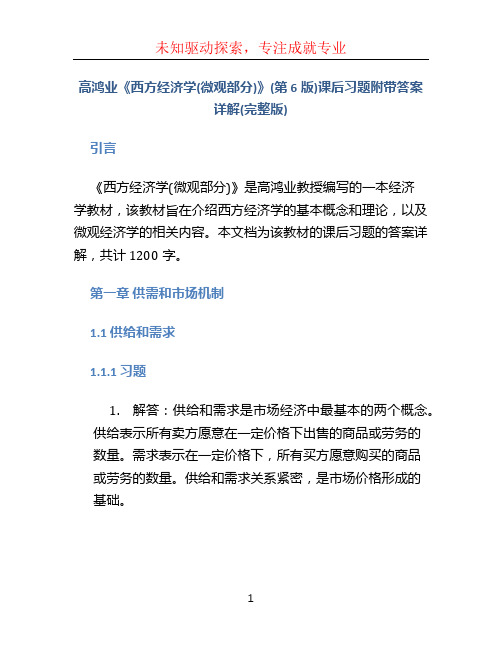
高鸿业《西方经济学(微观部分)》(第6版)课后习题附带答案详解(完整版)引言《西方经济学(微观部分)》是高鸿业教授编写的一本经济学教材,该教材旨在介绍西方经济学的基本概念和理论,以及微观经济学的相关内容。
本文档为该教材的课后习题的答案详解,共计1200字。
第一章供需和市场机制1.1 供给和需求1.1.1 习题1.解答:供给和需求是市场经济中最基本的两个概念。
供给表示所有卖方愿意在一定价格下出售的商品或劳务的数量。
需求表示在一定价格下,所有买方愿意购买的商品或劳务的数量。
供给和需求关系紧密,是市场价格形成的基础。
备注:在这道习题中,要求解答供给和需求的概念以及它们之间的关系。
可以简单明了地解释供给和需求的含义,以及它们在市场价格形成中的作用。
2.解答:需求曲线表示在一定价格下,市场上所有买方愿意购买的商品或劳务的数量。
需求曲线通常呈现负斜率,即价格上升时,需求量下降;价格下降时,需求量增加。
这是因为随着价格的上升,购买商品或劳务的成本增加,一部分买方愿意放弃购买;价格下降时,购买商品或劳务的成本减少,买方的购买欲望增加。
备注:这道习题要求解答需求曲线的含义以及变化规律。
在解答中,可以提到需求曲线的负斜率,以及价格对需求量的影响。
3.解答:供给曲线表示在一定价格下,市场上所有卖方愿意出售的商品或劳务的数量。
供给曲线通常呈现正斜率,即价格上升时,供给量增加;价格下降时,供给量减少。
这是因为随着价格的上升,出售商品或劳务的利润增加,卖方愿意增加供给;价格下降时,利润减少,卖方愿意减少供给。
备注:这道习题要求解答供给曲线的含义以及变化规律。
在解答中,可以提到供给曲线的正斜率,以及价格对供给量的影响。
1.1.2 答案1.答案:供给和需求是市场经济中最基本的两个概念。
供给表示所有卖方愿意在一定价格下出售的商品或劳务的数量。
需求表示在一定价格下,所有买方愿意购买的商品或劳务的数量。
供给和需求关系紧密,是市场价格形成的基础。
高鸿业微观经济学第六版课后答案——最全最详细最专业

高鸿业微观经济学第六版课后答案——最全最详细最专业内容第一部分笔记和课后习题(含考研真题)详解第1章引论1.1 复习笔记一、什么是经济学1.经济学的定义关于经济学,迄今为止,还没有一个完全统一的定义。
经济学大师萨缪尔森在其著作《经济学》中给出的定义是:经济学研究的是社会如何利用稀缺的资源以生产有价值的商品,并将它们分配给不同的个人。
(1)稀缺经济学所说的稀缺是指在给定的时间内,相对于人的需求(欲望)而言,经济资源的供给总是不足的。
一方面,人类对经济物品的欲望是无限的;另一方面,用来满足人类欲望的经济物品是有限的。
因此,现实生活中便存在着资源的有限性和人类欲望与需求的无限性之间的矛盾。
(2)资源的有效配置资源的稀缺性决定了任何一个经济社会都必须采用一定的方式对资源进行有效的配置,以实现资源的最优利用。
从资源稀缺性的角度出发,经济学的研究对象或者说研究任务是:研究人们如何进行选择来使稀缺的或有限的资源生产各种商品和服务并把它们分配给不同的社会成员提供消费。
2.经济学的基本问题为了有效率地使用稀缺资源,以满足人们的各种欲望和需求,任何社会或国家都必须解决以下四个基本经济问题:(1)生产什么产品,各生产多少?面对稀缺的经济资源,人类需要权衡各种需求的轻重缓急,确定生产什么产品,生产多少,以满足比较强烈的需求。
(2)用什么方法去生产?由于各种生产要素一般都有很多用途,各种生产要素之间也大多存在一定的替代关系,所以同一种产品的生产往往可以采用很多方法,但它们的生产效率却不尽相同。
经济社会必须在各种可供选择的资源组合中,确定哪一种组合是成本最低、效率最高的生产方法。
(3)生产出来的产品如何在社会成员之间进行分配?因为资源存在稀缺性,没有人能获得他想要的一切,因此每个社会都必须建立某种机制来分配产品。
(4)何时生产?何时生产是指资源利用的时间配置,即发展计划。
正因为资源的稀缺性,所以必须做好动态规划,以达到可持续发展的目的。
曼昆《经济学原理》第6版-微观经济学分册-第4章-课后习题答案P92-P94.doc

第二篇市场如何运作第四章供给与需求的市场力量复习题1.什么是竞争市场?简单描述除了完全竞争市场之外的市场类型。
答:竞争市场是有许多买者与卖者,以至于每个人对市场价格的影响都微乎其微的市场。
除了完全竞争市场之外,还有垄断市场。
在这个市场上只有一个卖者,他决定价格。
这个卖者被称为垄断者。
还有寡头市场,在这个市场上有几个并不总是主动竞争的卖者,他们提供相似或相同的产品。
通常情况下,寡头们会尽力联合起来,避免激烈的竞争,收取较高的市场价格。
还有垄断竞争市场,这是一个有许多提供相似但不相同产品的企业的市场结构。
由于各自提供的产品不同,每个企业对产品的价格都有一定的影响力。
2.什么是需求表和需求曲线?它们如何相关联?为什么需求曲线向右下方倾斜?答:需求表是表示一种物品价格与需求量之间关系的表格,需求曲线是表示一种物品价格与需求量之间关系的图形。
需求曲线将需求表用图形的形式表现出来,需求表是需求曲线上若干个点的坐标的数字表格排列。
需求曲线向右下方倾斜是因为在其他条件不变的情况下,随着价格上升,需求量会减少。
3.消费者嗜好的变化引起了沿着需求曲线的变动,还是需求曲线的移动,价格的变化引起了沿着需求曲线的变动,还是需求曲线的移动?答:消费者嗜好的变化引起了需求曲线的移动,价格的变化引起了沿着需求曲线的变动。
4.Popeye的收入减少了,结果他买了更多的菠菜。
菠菜是低档物品,还是正常物品? Popeye菠菜的需求曲线是什么样的?答:菠菜对波匹来说是低档物品。
因为Popeye的收入减少了,他对菠菜的需求量反而增大。
波匹菠菜的需求曲线是向右下方倾斜的。
5.什么是供给表和供给曲线,它们如何关联?为什么供给曲线向石上方倾斜?答:供给表是表示一种物品价格与供给量之间关系的表格,供给曲线是表示一种物品价格与供给量之间关系的图形。
供给曲线是供给表的图形表示,供给表是供给曲线上点的坐标的数字排列。
因为在其他因素不变时,价格上升,供给量上升,所以供给曲线向右上方倾斜。
微观经济学第六版课后答案--微观经济学--英文原版-CH02PINDYCK课件

3. Determine how taxes, subsidies, tariffs and import quotas affect consumers and producers
2. Qs > QD 3. Price falls to the
market-clearing price 4. Market adjusts to equilibrium
QD Q0
QS Quantity
©2005 Pearson Education, Inc.
Chapter 2
19
The Market Mechanism
There is excess supply - surplus Downward pressure on price Quantity demanded increases and quantity
supplied decreases The market adjusts until new equilibrium is
Other Variables Affecting Supply
Costs of Production
Labor Capital Raw Materials
Lower costs of production allow a firm to produce more at each price and vice versa
In equilibrium
曼昆《经济学原理》第6版 微观经济学分册 第11章 课后习题答案P234-P236
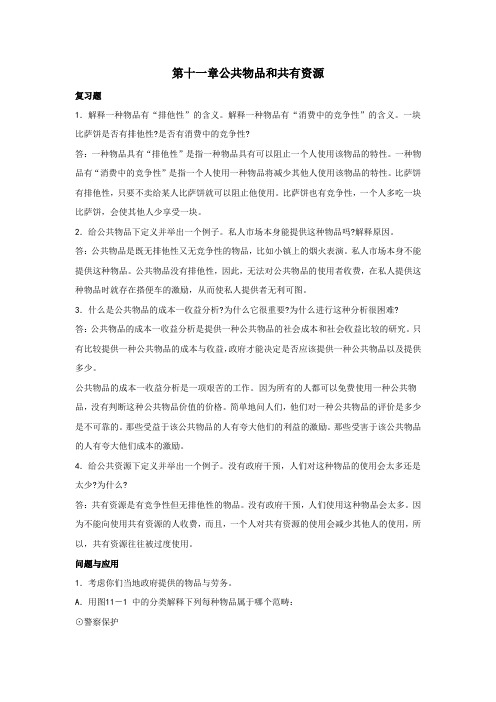
第十一章公共物品和共有资源复习题1.解释一种物品有“排他性”的含义。
解释一种物品有“消费中的竞争性”的含义。
一块比萨饼是否有排他性?是否有消费中的竞争性?答:一种物品具有“排他性”是指一种物品具有可以阻止一个人使用该物品的特性。
一种物品有“消费中的竞争性”是指一个人使用一种物品将减少其他人使用该物品的特性。
比萨饼有排他性,只要不卖给某人比萨饼就可以阻止他使用。
比萨饼也有竞争性,一个人多吃一块比萨饼,会使其他人少享受一块。
2.给公共物品下定义并举出一个例子。
私人市场本身能提供这种物品吗?解释原因。
答:公共物品是既无排他性又无竞争性的物品,比如小镇上的烟火表演。
私人市场本身不能提供这种物品。
公共物品没有排他性,因此,无法对公共物品的使用者收费,在私人提供这种物品时就存在搭便车的激励,从而使私人提供者无利可图。
3.什么是公共物品的成本一收益分析?为什么它很重要?为什么进行这种分析很困难? 答:公共物品的成本一收益分析是提供一种公共物品的社会成本和社会收益比较的研究。
只有比较提供一种公共物品的成本与收益,政府才能决定是否应该提供一种公共物品以及提供多少。
公共物品的成本一收益分析是一项艰苦的工作。
因为所有的人都可以免费使用一种公共物品,没有判断这种公共物品价值的价格。
简单地问人们,他们对一种公共物品的评价是多少是不可靠的。
那些受益于该公共物品的人有夸大他们的利益的激励。
那些受害于该公共物品的人有夸大他们成本的激励。
4.给公共资源下定义并举出一个例子。
没有政府干预,人们对这种物品的使用会太多还是太少?为什么?答:共有资源是有竞争性但无排他性的物品。
没有政府干预,人们使用这种物品会太多。
因为不能向使用共有资源的人收费,而且,一个人对共有资源的使用会减少其他人的使用,所以,共有资源往往被过度使用。
问题与应用1.考虑你们当地政府提供的物品与劳务。
A.用图11-1 中的分类解释下列每种物品属于哪个范畴:⊙警察保护⊙铲雪⊙教育⊙乡间道路⊙城市街道答:⊙警察保护属于自然垄断,因为它有排他性却无竞争性。
曼昆《经济学原理》第6版微观经济学分册第13章课后习题答案P280-P283

第十三章生产成本复习题1.企业总收益、利润和总成本之间的关系是什么?答:企业利润=总收益-总成本2.举出一个会计师不算做成本的机会成本的例子。
为什么会计师不考虑这种成本?答:企业家花时间和精力经营管理企业,他的机会成本是从事其他工作所能赚到的工资。
这种机会成本会计师不算做成本。
因为会计师分析经营活动的依据是货币的流人和流出,隐性机会成本不引起企业的货币流动。
因此,会计师不考虑它。
3.什么是边际产量?边际产量递减意味着什么?答:边际产量是增加一单位投入所引起的产量的增加。
边际产量递减意味着一种投入的边际产量随着投入量的增加而减少。
4.画出表示劳动的边际产量递减的生产函数。
画出相关的总成本曲线。
(在这两种情况下,都要标明坐标轴代表什么。
)解释你所画出的两个曲线的形状。
答:生产函数表示雇佣的工人数量和生产量之间的关系。
随着工人数量增加,生产函数变得增加,生产函数变得平坦,这反映了边际产量递减。
由于边际产量递减,边际成本递增,随着产量增加,总成本曲线变得较为陡峭。
图13-1劳动的边际产量递减的生产函数图13-2总成本曲线5.叙述总成本、平均总成本和边际成本的定义。
它们之间的关系是怎样的?答:总成本是指企业购买生产投入支付的量。
平均总成本是总成本除以产量。
边际成本指额外-单位产量所引起的总成本的增加。
平均总成本=总成本/产量边际成本=总成本变动量/产量变动量6.画出一个典型企业的边际成本曲线和平均总成本曲线。
解释为什么这些曲线的形状是这样,以及为什么在那一点相交。
答:图13-3典型企业的边际成本和平均总成本典型企业的边际成本曲线呈U型。
因为企业在刚开始时,生产能力有剩余,增加一单位的投入量,边际产量会高于前一单位的投入,这样就出现一段边际成本下降。
生产能力全部被利用之后,再增加边际投入,就会出现边际产量递减,边际成本递增。
于是,边际成本曲线呈现U型。
典型企业的边际总成本曲线呈U型。
平均总成本线反映了平均固定成本和平均可变成本的形状。
微观经济学曼昆第六版课后答案

微观经济学曼昆第六版课后答案【篇一:曼昆《经济学原理(微观经济学分册)》(第6版)课后习题详解(第1章经济学十大原理)】class=txt>第1篇导言第1章经济学十大原理课后习题详解跨考网独家整理最全经济学考研真题,经济学考研课后习题解析资料库,您可以在这里查阅历年经济学考研真题,经济学考研课后习题,经济学考研参考书等内容,更有跨考考研历年辅导的经济学学哥学姐的经济学考研经验,从前辈中获得的经验对初学者来说是宝贵的财富,这或许能帮你少走弯路,躲开一些陷阱。
以下内容为跨考网独家整理,如您还需更多考研资料,可选择经济学一对一在线咨询进行咨询。
一、概念题1.稀缺性(scarcity)答:经济学研究的问题和经济物品都是以稀缺性为前提的。
稀缺性指在给定的时间内,相对于人的需求而言,经济资源的供给总是不足的,也就是资源的有用性与有限性。
人类消费各种物品的欲望是无限的,满足这种欲望的物品,有的可以不付出任何代价而随意取得,称之为自由物品,如阳光和空气;但绝大多数物品是不能自由取用的,因为世界上的资源(包括物质资源和人力资源)是有限的,这种有限的、为获取它必须付出某种代价的物品,称为“经济物品”。
正因为稀缺性的客观存在,地球上就存在着资源的有限性和人类的欲望与需求的无限性之间的矛盾。
经济学的一个重要研究任务就是:“研究人们如何进行抉择,以便使用稀缺的或有限的生产性资源(土地、劳动、资本品如机器、技术知识)来生产各种商品,并把它们分配给不同的社会成员进行消费。
”也就是从经济学角度来研究使用有限的资源来生产什么、如何生产和为谁生产的问题。
2.经济学(economics)答:经济学是研究如何将稀缺的资源有效地配置给相互竞争的用途,以使人类的欲望得到最大限度满足的科学。
时下经常见诸国内报刊文献的“现代西方经济学”一词,大多也都在这个意义上使用。
自从凯恩斯的名著《就业、利息和货币通论》于1936年发表之后,西方经济学界对经济学的研究便分为两个部分:微观经济学与宏观经济学。
- 1、下载文档前请自行甄别文档内容的完整性,平台不提供额外的编辑、内容补充、找答案等附加服务。
- 2、"仅部分预览"的文档,不可在线预览部分如存在完整性等问题,可反馈申请退款(可完整预览的文档不适用该条件!)。
- 3、如文档侵犯您的权益,请联系客服反馈,我们会尽快为您处理(人工客服工作时间:9:00-18:30)。
习题一1. 简释下列概念:稀缺:指相对于人的无穷无尽的欲望而言,“经济物品”以及生产这些物品的资源总是不充分的或者说不足的。
自由物品:指人类无需通过努力就能自由取用的物品,如阳光、空气等,其数量是无限的。
经济物品:指人类必须付出代价方可得到的物品,即必须借助生产资源通过人类加工出来的物品。
生产可能性边界:指在既定的经济资源和生产技术条件下所能达到的各种产品最大产量的组合的轨迹,又叫生产可能性曲线。
自给经济:一种经济体制,其特点是每个家庭生产他们消费的大部分物品,扩大一点说,是每个村落生产他们消费的大部分物品,只有极少数消费品是与外界交换来的。
在这种体制下,资源配置和利用由居民的直接消费所决定,经济效率低下。
计划经济:一种经济体制,其基本特征是生产资料归政府所有,经济的管理实际上像一个单一的大公司。
在这种体制下,资源配置和利用由计划来解决。
市场经济:一种经济体制,其基本特征是产权明晰,经济决策高度分散。
这种经济为一只“看不见的手”所指引,资源配置和利用由自由竞争的市场中的价格机制来解决。
混合经济:一种经济体制,其基本特征是生产资料的私人所有和国家所有相结合,自由竞争和国家干预相结合,因此也是垄断和竞争相混合的制度。
在这种体制下,凭借市场制度来解决资源配置问题,依靠国家干预来解决资源利用问题。
微观经济学:西方经济学的两大组成部分之一,它以单个经济单位(居民户、厂商以及单个产品市场)为考察对象,研究单个经济单位的经济行为,以及相应的经济变量的单项数值如何决定。
宏观经济学:西方经济学的两大组成部分之一,以整个国民经济活动作为考察对象,研究社会总体经济问题以及相应的经济变量的总量是如何决定的及其相互关系。
总体经济问题包括经济波动、经济增长、就业、通货膨胀、国家财政、进出口贸易和国际收支等。
实证经济学:在解释经济运行时从客观事实出发,力求说明和回答经济现象“是什么”和“为什么” 并借以预测人们经济行为的后果,而不对事物作好坏、善恶的评价。
规范经济学:以一定的价值判断为岀发点,提岀行为标准,作岀“应当”与“不应当”的评价,阐述怎样才能符合这样的标准。
内生变量:是指由经济模型内部结构决定的变量。
外生变量:指不是由经济模型中的变量决定的,而是由外部因素(如政治,自然)决定的变量。
存量:是一定时点上存在的变量的数值。
流量:是一定时期内发生的变量变动的数值。
局部均衡:是假定在其他条件不变的情况下来分析某一时间、某一市场的某种商品(或生产要素)的供给与需求达到均衡时的价格决定。
一般均衡:在分析某种商品价格决定时,是在各种商品和生产要素的供给、需求、价格相互影响的条件下来分析所有商品和生产要素的供给和需求同时达到均衡时所有商品的价格如何被决定。
2. 你认为研究人们的消费问题是属于微观经济学还是宏观经济学的对象?答:微观经济学和宏观经济学不是仅从概念上就可简单加以区分的。
消费这个概念和问题,微观经济学和宏观经济学中都有,但含义和研究的角度不一样。
在微观经济学中,研究消费主要是研究消费者行为(选择),即根据预算约束,消费者如何按自己的偏好选购消费品以实现效用极大化;而在宏观经济学中,研究消费主要是研究社会的总消费支岀水平如何决定,及如何影响总需求水平等。
3. 经济物品是指(D )。
A.有用的物品;E.稀缺的物品;C.要用钱购买的物品;D.有用且稀缺的物品。
4. 一国生产可能性曲线以内的一点表示( B )。
A.通货膨胀;E.失业或者说资源没有被充分利用;C.该国可利用的资源减少以及技术水平降低;D. —种生产品最适度产出水平。
5. 生产可能性曲线说明的基本原理是(B )A. —国资源总能被充分利用;E.假定所有经济资源能得到充分利用,则只有减少丫物品的生产才能增加X物品的生产;C.改进技术引起生产可能性曲线向内移动;D.经济能力增长惟一决定于劳动力数量。
6. 下列命题中哪一个不是实证经济学命题?(C )。
//A. 1982年8月联储把贴现率降到10% ;B. 1981年失业率超过9% ;C .联邦所得税对中等收入家庭是不公平的;D.社会保险税的课税依据现在已超过30000美元。
7. 以下问题中哪一个不是微观经济学所考察的问题?( B )A. —个厂商的产出水平;B.失业率的上升或下降;C.联邦货物税的高税率对货物销售的影响;D.某一行业中雇用工人的数量8. 什么是经济理性主义?日常生活中有哪些行为是符合这个原则的,有没有“非理性”或“反理性”行为?自私自利和损人利己是理性的还是反理性的,为什么?您给岀的答案是实证性的还是规范性的?答:经济理性主义是指这样一种观点,这种观点认为人在经济生活中总是受个人利益或利己的动机所驱使,总能认真地对各种可能的抉择权进行比较,以便找岀一个能使他耗费给定的代价取得最大限度利益的所谓最优方案。
在日常生活中,人们花费一定金钱买进消费品时总是力求消费品提供最大效用,厂商经营总是力求利润最大,要素岀售者提供生产要素则力求收益极大。
总之,人们无论从事何种经济活动,都力求能带来最大利益,带来最大限度满足。
一切头脑正常的人,即所谓有理性的人都会这样行动,不可能有所谓“非理性”或“反理性”的行为。
然而,理性行为不一定是自私自利的,更不一定是损人利己的。
因为如果人们不把自私自利和损人利己作为自己行为所追求的目标,而把助人为乐看作是自己行为的准则的话,则自私自利和损人利己就不会成为他们的理性行为。
当然,在自私自利或损人利己主义者看来,自私自利和损人利己行为就是理性行为。
所谓“宁可我负天下人,不愿天下人负我”,就是这样的人。
可见,如果我们说,理性行为不应当是自私自利及损人利己的行为,这种说法实际已经是规范性的而不是实证性的了。
因为这种说法实际上已包含着认为自私自利和损人利己是“不好的”、“不应当的”、“非理性的”这样一种价值判断了。
习题二1. 简释下列概念:需求:是指在某一特定时期内,对应于某一商品的各种价格,人们愿意而且能够购买的数量。
需求规律:一种普遍经济现象的经验总结,指在影响需求的其他因素既定的条件下,商品的需求量与其价格之间存在着反向的依存关系,即商品价格上升,需求量减少;商品价格下降,需求量增加。
需求的变动:指当商品本身的价格不变时,由于其他因素的变动引起的需求数量的变化。
供给:是指生产者(厂商)在一定时期和一定价格水平下愿意而且能够提供的某种商品的数量。
供给规律:一种普遍经济现象的经验总结,指:在影响供给的其他因素既定的条件下,商品的供给量与其价格之间存在着正向的依存关系,即商品价格上升,供给量增加;商品价格下降,供给量减少。
供给的变动:指当商品本身的价格既定时,由于其他因素的变动引起的供给数量的变化。
性需求的价格弹:是指一种商品的需求量对其价格变动的反应程度,其弹性系数等于需求量变动的百分比除以价格变动的百分比。
通常简称为需求弹性。
需求的收入弹性:是指一种商品的需求量对消费者收入变动的反应程度,其弹性系数等于需求量变动的百分比与收入变动的百分比之比。
需求的交叉弹性:是需求的交叉价格弹性的简称,指一种商品的需求量对另一种商品的价格变动的反应程度,其弹性系数等于一种商品需求量变动的百分比与另一种商品价格变动的百分比之比。
供给弹性:是一种商品的供给量对其价格变动的反应程度,其弹性系数等于供给量变动的百分比与价格变动的百分比之比。
均衡价格:是指消费者对某种商品的需求量等于生产者所提供的该商品的供给量时的市场价格。
供求规律:指均衡价格和均衡产量与需求均呈同方向变动,均衡价格与供给呈反方向变动,而均衡产量与供给呈同方向变动。
2. 下列情况发生时,某种蘑菇的需求曲线如何移动?⑴卫生组织发布一份报告,称食用这种蘑菇会致癌;⑵ 另一种蘑菇价格上涨了;⑶消费者收入增加了;⑷培育蘑菇的工人工资增加了。
答:⑴对此蘑菇的需求曲线会向左移。
因为卫生组织发布的该蘑菇会致癌的报告会使得人们普遍产生对食用此种蘑菇的恐惧心理,从而在任一价格水平下大大减少对它的需求量。
⑵此蘑菇的需求曲线会向右移。
因为各个品种的蘑菇属于互替商品,当另一种蘑菇的价格上涨后人们会减少对那种蘑菇的需求量,并通过多消费此种蘑菇来实现替代。
因而在任一价格水平下增加了对此种蘑菇的需求量。
⑶此种蘑菇的需求曲线会向右移。
因为消费者收入的增加意味着他们购买力的增强,这将使他们增加对这种蘑菇在内的正常商品的需求量,并且在任一价格水平下都是如此。
⑷此种蘑菇的需求曲线不变,如果不考虑培育蘑菇的工人作为消费者对此种蘑菇的需求的话。
因为培育蘑菇的工人工资增加只影响蘑菇的供给成本进而影响其供给曲线,对需求曲线则不发生影响。
3. 假设一个坐标图上有两条形状为直线但斜率不同的需求曲线,在这两条需求曲线的相交之点的弹性是否相等?假定这两条相交的需求曲线不是直线而是曲线,交点上弹性是否相等?答:两条斜率不同的直线性需求曲线在相交之点各自的弹性是不相等的,斜率绝对值小(坡度较平缓)的那条需求曲线在交点处的弹性大一些。
O百度文库如上图,D i 、D 2分别为两条斜率不同的线性需求曲线,它们与横轴分别相交于点 B 、D ,与纵轴分别相交于点A 、C ,两条需求线相交于点 OAE 。
这里,D i 之斜率绝对值 K i,D 2之斜率绝对值 K 2OBOC OD显然,K 2 OC2OD OB DBOA AC ACOB DB DBOA 由几何表述法可知在交点 E 处, D i 之弹性系数E diOBEBK i ,即D 2斜率绝对值较大。
,D 2之弹性系数FB ED 。
因 EF II OC ,EC E d2 EA FD,显然FO的需求曲线ED FD ,则EC FOFD FBE皂Edi, d2FO册EB 故 -EA这表明在两条需求曲线交点处斜率绝对值较小(坡度较缓) 绝对值较大(坡度较陡)的需求曲线D 2的弹性系数E d2o两条曲线型的需求曲线在它们相交处的各自弹性也是不相等的。
FOFOFO,故 E diE d2。
D i 的弹性系数值E di 大于斜率e i 、D 2的切线为e 2。
显然,D i 切线e i 的斜率小于D 2切线e 的斜率。
而需求的点价格弹性系数公式为E ddQ P i dP Q dp ,dQ在D i 、D 2交点E ,虽然它们具有相同的坐标位置,即有相同P 与Q 的数值,但由于 D 2切线e 2的斜率,因此D i 的弹性大于D 2的弹性,即在交点处它们具有不同的弹性。
D i 切线ei 的斜率小于4.下图中有三条为直线的需求曲线。
P⑴试比较a、b和c点的需求价格弹性⑵试比较a、d和e点的需求价格弹性答:⑴用E a、E b和E c分别代表a、b和c点的需求弹性,则由于aK JO 严bG JO L cH JOE a,E b E caF JF bF JF cF JF因而E a=E b=E c⑵用E a、E d和E e分别代表a、d和e点的需求弹性,则由于aK IK dG IG l eH IHE a,E d E eaF IO dF IO eF IO又由于IK IG IH因而E a〈E d〈E e5. 如果考虑到提高生产者的收入,那么对农产品和轿车一类高级消费品应采取提价还是降价的办法?为什么?答:对农产品,应采取提价的办法;对轿车这类高级消费品则应采取降价的办法。
